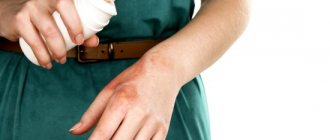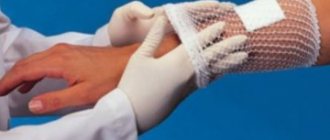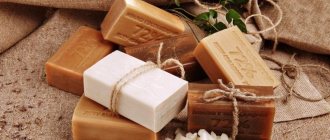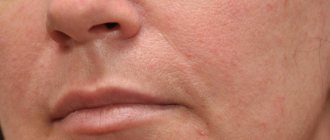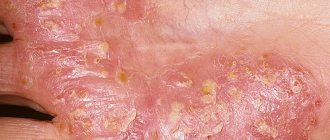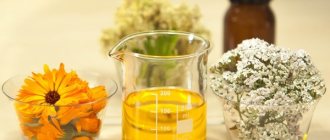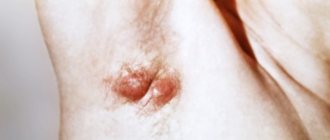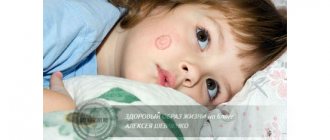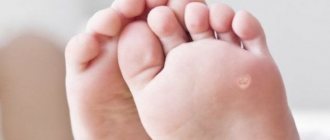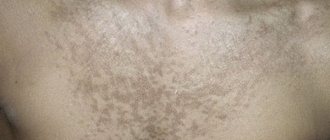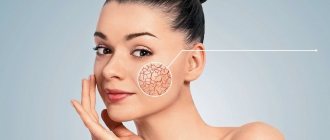Dry calluses or corns cause a lot of discomfort. Painful sensations appear, wearing your favorite shoes becomes painful. In addition, such defects cannot be called attractive. Corns disfigure the foot. If the problem is not dealt with in a timely manner, it will become widespread.
At the initial stage, calluses can be removed using a folk remedy or a special pharmaceutical ointment. In advanced cases, you will have to resort to surgical intervention.
Why do corns appear?
A person will get rid of a problem if he initially finds out what triggered its appearance. Dry calluses are keratinized layers of skin on the foot. In most cases, a defect appears due to regular mechanical pressure on a certain area. This is due to wearing low-quality or unsuitable shoes. The skin is injured, epidermal cells die. This leads to a decrease in blood supply to the deep layers of skin in this area. As a result, the callus becomes deep and its size increases.
Most often, corns appear at the base of the toes or on the balls of the feet. That is, in those places where there is the greatest pressure on the sole. Many older people suffer from corns with a core. Prolonged mechanical impact leads to the formation of a large area of keratinized skin on the feet. Over time, the callus grows into the tissue, a root (rod) appears, which, when pressed, causes unpleasant sensations such as sharp pain, numbness of the affected area, and burning.
If serious calluses appear that cannot be eliminated with the help of traditional medicine, it is worth making an appointment with a dermatologist. The specialist will examine the affected area and choose the most suitable method for removing the defect.
Uncomfortable shoes are a common cause of corns.
Few people know that corns can be both an independent disease and a symptom of many pathological processes in the body. This may include:
- Overweight. Everything is simple here: the more pressure the foot experiences, the greater the likelihood of developing corns. The problem occurs in almost all people whose body weight exceeds 100 kg.
- Disruption of the functioning of internal organs and systems. Calluses on the feet often develop in people who suffer from hyperhidrosis of the feet. In addition, people who have diseases of the endocrine system often face the problem.
- Orthopedic pathologies. So, if one of the patient’s legs is even slightly shorter than the other, the longer limb will certainly experience excessive stress. People with flat feet often develop calluses on the outside of their feet.
- Infections. People who have the papilloma virus in their blood most often experience calluses. Pathogenic microflora activates its activity under favorable conditions. That is, when local immunity decreases. Regular injury to the same area on the foot will inevitably lead to the appearance of a growth.
Lack of basic hygiene is another reason for the appearance of corns on the feet. Regularly drying shoes, changing insoles, washing feet, and changing socks is necessary not only for aesthetic comfort. Such actions will help avoid the appearance of pathogenic microflora. These are various bacteria, fungi and viruses that can provoke the formation of growths and calluses.
What is a corn and what does it look like?
In medicine, corns are called seals located on the skin of the foot. They appear due to incorrect pressure on the foot when a person walks. For this reason, healthy skin cells die, and in their place hardened areas of various shapes appear. They constantly endure mechanical stress in the form of friction.
The corns are dry and do not have a clear boundary. These calluses are light gray or yellow-gray in color. The surface of the corn consists of small keratinized plates. If you do not take proper care of your feet, the plates may become larger.
Mechanical methods for removing calluses
Surgery to remove corns is a last resort. You should resort to it only if you cannot get rid of the problem in a conservative way. Only a professional stylist or cosmetologist can remove a callus surgically. Under no circumstances should you try to do this yourself at home.
Most often, the indication for surgical intervention is the presence of calluses on the feet with a core, which cause pain to the patient. All professional procedures to remove the defect do not cause discomfort to the patient and are carried out on an outpatient basis. The likelihood of complications developing is also minimized. In one session you can get rid of corns. If necessary, a specialist will apply local anesthesia.
If calluses appear too often, you should consult a doctor.
The most effective methods for removing calluses:
You can also read:Treatment of dry calluses on heels
- Drilling. The procedure is carried out in a cosmetology office using a special device. Callus removal can be performed during a regular pedicure session. The advantage of this method is that the damaged tissue is removed almost painlessly. A person may only feel a slight tingling sensation. However, drilling can only remove small core calluses. If the problem continues, you will have to resort to other methods.
- Laser. Getting rid of corns with a laser is not a cheap pleasure. However, the procedure is effective. With its help you can remove the largest neglected calluses. The work uses a carbon dioxide laser. It is considered the most painless. However, the procedure is in any case carried out using local anesthetics. The laser burns away the core of the callus, as well as the dead tissue present nearby. This technique is considered effective, since under the influence of high temperature all pathogenic microorganisms that provoke further development of the callus die. Therefore, the likelihood of developing an infection after surgery is minimized.
- Cryodestruction. The technique involves getting rid of the problem using liquid nitrogen. The specialist acts on the roughened area of the skin of the foot with extremely low temperatures (up to -200 degrees Celsius). As a result, the callus tissue completely dies and necrosis occurs. This method of removing calluses is great for people who develop allergies to anti-callus medications. However, in rare cases, the body can react negatively to extremely low temperatures.
When removing calluses using any of the above methods, the patient should undergo proper rehabilitation. The damaged area requires proper care to avoid infection in the wound and re-formation of calluses. As a rule, a crust forms at the site of exposure. New epithelium grows underneath it. Under no circumstances should you remove this crust yourself. It will disappear on its own. All you need to do is reduce the load on the foot (wear comfortable shoes) and treat the wound with a suitable antiseptic.
Drilling is an effective and inexpensive method for removing calluses
If the described techniques are not available, the callus can be removed with a scalpel in the surgical office. This method is considered quite painful and necessarily requires local anesthesia. In addition, this often affects healthy tissues, there is a risk of infection, and the rehabilitation period increases. It is not advisable to resort to such a radial technique.
What treatment methods are there?
Depending on how advanced the problem is, different options may be used to get rid of calluses on the heels. If it has just appeared, ordinary drugs from the pharmacy will also help. Difficult situations will require medical attention and special procedures. Below we consider the main treatment methods.
- Use of keratolytic agents. Creams, gels and ointments allow you to soften the stratum corneum and remove it. The main component of the preparations is salicylic acid. Before using them, you need to steam your feet well. Apply only to non-problem areas, avoiding contact with healthy skin. Once the dead cells become soft, they can be removed using a pumice stone. In order to achieve the maximum positive effect, the products are used for several days. A fairly simple way to remove corns.
- Use of antimosol patches. This remedy is one of the most popular, as it allows you to quickly get rid of corns on the heels, and it is also convenient to use. You need to stick the patch on the surface of the growth and after a certain time, peel it off along with the stratum corneum. It should be worn for 2-3 days. A fairly simple way to remove a callus on the heel.
- Hardware pedicure. It involves the use of a special device with an attachment that grinds dead epidermis. In order for the result to become noticeable, you need to undergo several procedures.
- Laser removal. The action of the laser allows you to destroy the stratum corneum as quickly, efficiently and painlessly as possible. After the procedure, there are no scars or other skin defects.
- Cryodestruction. It involves the use of liquid nitrogen, which causes the death of the stratum corneum with its subsequent rejection. After a few days, new skin with a smooth surface forms in place of the corns.
- Radical method. When the corns are in an advanced form, it is necessary to resort to surgical intervention. The doctor uses a small knife to remove dead cells.
How to get rid of corns will be decided based on their condition. If they have just appeared, simple remedies will do.
Using a hardware pedicure you can remove chafing
When seeking medical help, your doctor will tell you how to treat corns on your heels effectively and correctly. It is important to find out the factors that caused the problem and try to eliminate them.
There are a number of the most effective procedures, which include the following:
- The use of creams containing keratolytic components. These include acids such as salicylic, lactic, and glycolic. It is important to apply such products only to the area of the corn: getting the cream on healthy skin can cause damage. To make application easier, you can cut out an area for the corns in the patch and stick it on, covering the unaffected area. Knowing how to remove corns in this way, you can soften the rough skin in a few procedures, and it will be much easier to remove it.
- Application of anti-callus patch. It must be glued to the corns and left for the whole day. The components with which the patch is impregnated soften rough skin, and its removal is much easier.
- Method using liquid nitrogen. The targeted action on the affected areas of the skin allows you to freeze them and easily remove them. This procedure should be carried out in a beauty salon.
- Laser treatment. It is considered one of the most effective procedures when it is necessary to remove corns. This technique is distinguished by safety: only affected areas of the skin are removed, and no damage to healthy skin occurs.
- Performing pedicures: both classic and hardware. In addition to regular home procedures, it is recommended to set up a salon to provide the correct hardware pedicure.
- Regular massage also helps improve the condition of the feet and is an excellent preventative measure.
Diet correction
To improve the condition of the skin on your feet, it is also important to pay close attention to your diet. You should include foods containing vitamin A (carotene) and vitamin E (tocopherol) in your diet.
Foods that contain a lot of carotene:
- carrot;
- liver;
- butter;
- processed cheese;
- cottage cheese;
- garlic feathers;
- broccoli;
- wild garlic;
- seaweed;
- oysters
Foods that contain a lot of tocopherol:
- nuts: almonds, peanuts, pistachios, hazelnuts;
- sea buckthorn;
- dried apricots;
- wheat;
- rose hip;
- spinach;
- sorrel;
- viburnum;
- salmon;
- zander;
- oatmeal;
- prunes.
Traditional medicine offers a number of effective recipes for eliminating corns on the heels. But before using any remedy, you need to consult a doctor about safety and effectiveness: not every person is suitable for traditional recipes.
Among the most effective folk remedies for correcting corns are the following:
- You need to chop half an onion and a few cloves of garlic. After this, steam your feet and apply a mixture of healing ingredients to the surface of the corns. Secure the compress with bandages and put on warm socks. Remove after three hours, rinse, apply rich cream.
- Grate a raw potato, apply to the affected area, secure with a bandage, and put on socks. This compress can be left overnight; in the morning it should be washed off and cream applied to the feet.
- Apply tomato paste to the corns area, fix, and leave overnight. After waking up, rinse off and apply cream to your feet. Active acids in tomato paste perfectly soften rough skin of the feet.
- Vegetable oil is good for softening the skin. You can use regular sunflower oil, olive oil or flaxseed oil. It is recommended to apply a compress with slightly warmed oil at night and wash it off with soap in the morning.
- A variety of baths will help soften rough skin on your heels. To prepare them, you can use sea salt, herbal infusions, and essential oils. To eliminate corns, this recipe will help: dilute 2 tablespoons of salt and soda in 2 liters of hot soapy solution. Steam your feet until the water cools, then remove the callus using a pedicure grater or pumice stone.
- Crushed aloe pulp is applied to the corns, then secured with a plaster. The top is wrapped with film. This compress should be removed after 2 hours.
- Propolis is also successfully used to get rid of rough skin. It should be kneaded and applied to the affected area, then fixed with cling film and put on socks. Can be left on all day.
To begin, choose comfortable shoes. Eliminate all options with heels or reduce the period of their use. A simple and productive way to get rid of corns is salon procedures using the hardware pedicure method. The rapidly rotating nozzles painlessly remove rough layers of skin. However, this is not a cheap procedure, which many consider dangerous due to the rapid rotation of the nozzles.
Therefore, most people prefer conservative treatment methods at home, which will help overcome the problem in a few days. The basic principle of treatment at home is to apply a soft cream or patch to the rough areas at night.
Keratolytic cream
Effectively softens hard layers of skin, allowing you to quickly get rid of compaction. The basis of the drug is salicylic acid. Apply cream to the keratinized area and seal it with a band-aid. In the morning, carefully remove the patch, wash off the remaining drug with water, and remove the loose surface layer by layer with pumice until we reach living skin. The procedure is carried out in several stages.
Anti-callus patches
Sold without a prescription at the pharmacy. Easy to use. The main feature is to prevent the patch from touching non-hardened skin. We cut out the fragment of the required shape, and then attach it to the painful place. For stability, we attach the medical plaster with a regular one and do not remove it for 2-3 days. During this period, the corns will completely disappear.
To forget about small corns forever, we use all kinds of cosmetic oils. To do this, saturate cotton socks with oil and put them on before bed, and in the morning remove the growths with a nail file or brush.
We also use aspirin or ibuprofen to relieve pain symptoms, swelling and redness. Sometimes a cold compress is enough.
There are many traditional methods that get rid of dead skin. Here are some options:
- Onion compress helps effectively get rid of corns. Phyto acids and essential substances contained in it have an exfoliating effect.
- Propolis in the form of a compress nourishes and saturates the skin. It is kneaded and placed on the painful area.
- Compresses from freshly ground celandine in a meat grinder give a good effect.
- Aloe leaves, cut lengthwise and the pulp placed on the disturbing area, will also help solve the problem.
At the same time as getting rid of corns, take a course of multivitamins, because skin problems indicate an insufficient amount of vitamins in the body.
Not only adults, but also children are susceptible to the formation of corns on the heels. Children's skin is quite delicate, so wearing shoes with very thin soles and rough seams can cause corns to appear over time.
The same steaming foot baths will be the first to come to the rescue. But, unlike treatment for an adult, you should not add alcohol or soda to a child’s bath. It is also not recommended to use compresses made from vinegar, onion and garlic. Since baby's skin is very delicate, these ingredients can harm it.
Medicines against calluses
In the pharmacy you can find many drugs, the main function of which is to soften keratinized tissue. At the initial stage, with their help it will be possible to effectively get rid of corns on the heels and cracks. Salicylic acid is great for softening calluses. It is necessary to use ointments based on it. 10% salicylic acid ointment is an effective and inexpensive remedy for any calluses. The product can also be combined with other components. Benzoic acid shows a good effect.
Salicylic ointment will help quickly soften rough tissue
Manufacturers often include glycolic acid in anti-callus preparations. It has antimicrobial and antiviral effects, reducing the risk of infection at the site of callus formation.
Patches for corns are popular due to their ease of use and high effectiveness against small calluses. A special composition is applied to the product, which softens keratinized tissue and relieves pain. Regular use of the patch allows you to get rid of calluses in one to two weeks. In addition, the product protects the callus from excessive pressure and takes the load on itself. Salipod, Compeed and others are considered popular.
Plasters will help remove small calluses
“Lekar” cream is considered effective for small calluses. The active ingredient is urea, which effectively softens rough tissue, relieves pain and tired legs. The cream is suitable for use by almost everyone. The only contraindication is individual intolerance.
Any remedy for corns should be used after carefully studying the instructions for use.
Preventive measures
Prevention of dry calluses involves:
- Refusal of narrow shoes and high-heeled models, which contribute to improper distribution of the load on the foot;
- Correction of foot curvatures: flat feet, clubfoot, hallux valgus, varus deformity and other orthopedic disorders;
- Treatment of hormonal disorders - diabetes mellitus, leading to nervous and vascular disorders;
- Therapy for fungal skin infections, as well as their systematic prevention (use of individual hygiene products, sole wearing of shoes);
- Prevention and treatment of vascular pathologies of the lower extremities: varicose veins, atherosclerotic plaques in the arteries, etc.;
- Correction of inflammatory lesions of the joints of the feet - rheumatoid and gouty arthritis;
- Therapy for excessive sweating of the feet (botulinum toxin injections - “Botox”, clay masks);
- Reducing the load on the lower extremities: correction of body weight (to normal), normalization of lifestyle or professional activity (among runners, figure skaters, top models, ballerinas, etc.).
An effective method of preventing the disease is the use of orthopedic shoes, special insoles or “pads” for the toes. In this case, regular care of the skin of the feet is necessary, which consists of thoroughly exfoliating dead layers of skin.
Remember, treatment of corns is, first of all, a good prevention of the progression of the pathology. However, if severe pain or skin cracks appear, immediately contact a podiatrist!
How to get rid of corns using traditional methods?
Many plants, food products, and some natural components have the properties of softening rough tissues and relieving inflammation. Therefore, traditional medicine recipes are effectively used in the fight against corns.
At the initial stage of the problem, baths with sea water help well. It is not necessary to look for water directly from the source. It will be enough to purchase sea salt at the pharmacy. Pour a glass of salt (about 150 g) into a bowl of hot water and steam your feet for an hour. After this procedure, the skin becomes soft, the keratinized layers can be easily removed mechanically.
Sea salt baths are an effective way to get rid of calluses at home
Good results can be achieved if you take a bath with a teaspoon of iodine and a tablespoon of soda. It is necessary to keep your feet in the water for at least 40 minutes, periodically treating the rough areas with pumice stone or a rough brush.
Baths based on dairy products perfectly soften the skin. Cleopatra also practiced milk hygiene procedures for the beauty of the skin of her feet. A little sour milk or whey should be poured into a basin and keep your feet in it. The product needs to be heated a little. Cooling your feet can cause a decrease in immunity.
Fruit acids contained in lemon soften dead skin
You can perfectly get rid of corns with the help of fruit acids. A simple lemon is considered effective. Before going to bed, you should thoroughly steam the area with the callus, then apply the pulp of a sour fruit and secure it with a band-aid. It is advisable to keep the compress all night. The next morning the callus will be soft and can be removed with nail scissors.
Onions, garlic, celandine, aloe, propolis, etc. also have excellent softening properties. Everyone can choose the most suitable option for themselves.
ethnoscience
Treatment is carried out through baths, compresses and masks.
Baths
Most often, baths are prepared by adding sea salt, 10 milliliters of ammonia, iodine or 5 aspirin tablets to hot water. Other options are:
- a mixture of grated laundry soap, baking soda and chamomile flowers;
- infusion of birch leaves and soda;
- decoction of oat straw.
As a stand-alone remedy, baths are ineffective. They are usually used to steam out corns before applying compresses, creams or patches.
Compresses
The following can be used as a basis for a compress:
- chopped onion rings;
- prunes crushed in hot milk;
- a mixture of garlic and melted lard;
- heated propolis and celandine;
- crust of bread soaked in vinegar.
The compress is usually secured with a plaster or bandage, and a sock made of natural fabrics is put on top. The product is left overnight, and the procedure is repeated until the corns completely disappear.
Masks
The basis for masks against corns can be:
- a mixture of glycerin and vinegar in a ratio of 2:1;
- olive oil and orange pulp in equal volumes;
- aloe extract;
- potato decoction;
- a mixture of raw eggs, vinegar essence and vegetable oil in equal proportions;
- blue clay;
- ground coffee with the addition of sea salt and cinnamon in equal quantities (the basis for the mask is any oil).
One of these products is applied to clean, steamed skin (in the affected area) and left for half an hour. After which the corns are moisturized with nourishing cream or fat.
Reviews about the treatment of corns
Angelina, 27 years old, Severodonetsk I am the owner of curvy figures, so the problem of corns is familiar to me firsthand. I believe that it is better to regularly carry out prevention than to deal with the problem later. Every week I do a “relaxation” for my legs. I take baths with sea salt and remove dead skin particles. I carry out the procedure in the evening. This way I also relieve leg fatigue.
Masha, 30 years old, Moscow I didn’t think about the seriousness of the problem until recently. Previously, calluses appeared, but quickly went away. And recently I had to deal with a corns, which caused a lot of discomfort. He was terribly ill and did not allow me to use my favorite shoes. It turned out that it was a callus with a core. I removed it by drilling. And a problem arose because of Chinese high-heeled shoes. Now I buy only high-quality shoes from famous brands.
Softening corns at home
- The cosmetic defect is eliminated by daily 30-minute baths of hot whey from sour milk. Treatment of corns using this method requires a long time.
- To soften formations on the skin and relieve pain, rub your feet with castor oil twice a week at night and put on cotton socks.
- To soften the skin, apply mashed potatoes with honey or raisins, ground into a paste, for a day, then steam the foot and carefully remove the top whitened layer of skin with scissors, which have previously been disinfected with alcohol. In case of a cut, lubricate with iodine or brilliant green.
To completely get rid of corns, you need to repeat this procedure every day for a week, successively removing layers to the “base”. Otherwise the defect will appear again.
Then, every day, lubricate the “base” with fresh celandine juice three times at intervals of 5 minutes, having previously lubricated the healthy skin around it with Vaseline.
Treatment ends when the skin is completely clean and healthy.
Removing corns at home
- For general cleansing of the body, as well as for getting rid of salts in joints, removing corns and calluses, it is useful to take baths with the addition of birch leaves, black currants, nettles, St. John's wort, mint, thyme, strawberries - in any combination - pre-brewed in a saucepan. You can also add a little celandine, wormwood, and cornflower.
More beneficial than a bath for the whole body. But to remove corns on the feet and heels, you can do foot baths only. In any case, the body will receive the necessary vitamins and minerals. The water should not be too hot, the basin should not be enameled or plastic.
- In the morning before breakfast, after washing and thoroughly drying your feet and heels, apply saliva to the calluses and rub in thoroughly. Then put on cotton socks for half an hour and lubricate your feet with an antiseptic cream.
- In summer, to get rid of corns, apply plantain moistened with saliva to the heels and feet; in winter, use cabbage leaves instead of plantain. In some cases, the defect can be eliminated within two weeks.
- Dissolve 2 tbsp in 1.5 liters of warm water. soda, place the feet for 15 minutes. When finished, treat with pumice, wipe your feet and apply nourishing cream.
- Another remedy for corns: 2l. hot water dissolve 1 tbsp. crushed laundry soap, 1 tsp. soda, take baths every day for half an hour.
Modified: 08/07/2018
How to remove corns on heels?
Corns, or dry (hard) calluses of the feet, are slightly elevated areas of compaction of the stratum corneum of the epidermis. Several layers of dead skin give the callus a grayish-yellow color. What are the symptoms and how to properly treat corns on the heel?
Due to prolonged friction and pressure on the skin, its upper layers rapidly die off, without having time to peel off and be removed. Women and older people are more susceptible to the disease. There can be many provoking factors:
- long-term wearing of uncomfortable shoes, high-heeled shoes;
- thin soles in shoes;
- frequent walking barefoot;
- limb injury;
- frequent physical activity;
- larger socks;
- unsuitable insoles;
- obesity;
- diabetes mellitus and other chronic diseases;
- dermatological diseases (psoriasis, fungal infection);
- leatherette shoes;
- entry of a foreign body (splinter) into the skin;
- lack of hygiene;
- incorrect gait due to poor posture, curvature of the spine;
- professional sports (runners, skiers);
- various diseases and deformities of the foot (bursitis, arthritis, flat feet).
A corn is a limited, compacted area of a dirty yellow color, usually round in shape, rising above the level of the skin. The size can reach 1.5–2 cm. In itself, it is usually insensitive and painless. Pain occurs only when pressed and squeezed by tight shoes, walking, or due to some other provoking factor. The pain syndrome intensifies in the presence of cracks.

